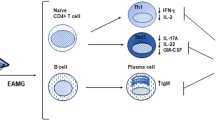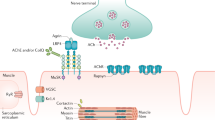Abstract
The basic abnormality in myasthenia gravis (MG) is a reduction of acetylcholine receptors (AChRs) at neuromuscular junctions, due to an autoimmune attack directed against the receptors1. Several lines of evidence support the idea that humoral immune mechanisms play an important part in this process: anti-AChR antibodies are present in the sera of more than 80% of myasthenic patients2–4; the pathogenicity of the antibodies has been demonstrated by passive transfer of IgG from myasthenic patients to mice which reproduces the typical features of MG in the recipient animals5,6; finally, procedures that reduce levels of anti-AChR antibody, such as plasmapheresis, produce improvement in the clinical symptoms of MG7. Present treatments of MG depend largely on the prolonged use of immunosuppressive drugs, which have significant drawbacks1,8–10, for they usually produce only a slow fall in antibody titres, and have toxic side effects. An agent that could produce a rapid and sustained fall of autoantibody titre might have wide application in the treatment of MG and other autoimmune diseases. In the course of testing immunosuppressive drugs for their effect in treating experimental autoimmune MG (EAMG), we discovered that the vehicle used to dissolve some of these agents, dimethyl sulphoxide (DMSO), itself produced a rapid and sustained fall of anti-AChR antibody titre. We now report similar results for a controlled trial of DMSO treatment in rats with EAMG.
Similar content being viewed by others
References
Drachman, D. B. New Engl. J. Med. 298, 136–142, 186–193 (1978).
Lindstrom, J. M., Seybold, M. E., Lennon, V. A. & Whittingham, S. Neurology 26, 1054–1059 (1979).
Mittag, T., Kornfeld, P., Tormay, A. & Woo, C. New Engl. J. Med. 294, 691–694 (1976).
Appel, S. H., Almon, R. R. & Levy, N. New Engl. J. Med. 293, 760–761 (1975).
Toyka, K. V. et al. New Engl. J. Med. 296, 125–131 (1977).
Howard, J. F. & Sanders, D. B. Neurology 30, 760–764 (1980).
Dau, P. C. (ed.) Plasmapheresis and Immunobiology of Myasthenia Gravis (Houghton Mifflin, Boston, 1979).
Hertel, G., Mertens, H. G., Ruether, P. & Ricker, K. in Plasmapheresis and the Immunobiology of Myasthenia Gravis (ed. Dau, P. C.) Ch. 29 (Houghton Mifflin, Boston, 1979).
Sanders, D. B., Howard, J. F. Jr, Johns, T. R. & Campa, J. F. in Plasmapheresis and the Immunobiology of Myasthenia Gravis (ed. Dau, P. C.) 289–306 (Houghton Mifflin, Boston, 1979).
Rowland, L. P. Trans. Am. neurol. Ass. 133, 277–302 (1978).
Eldefrawi, M. E. & Eldefrawi, A. T. Archs Biochem. Biophys. 159, 362–373 (1973).
Hucker, H. B., Ahmad, P. M. & Miller, E. A. J. Pharmac. exp. Ther. 154, 176–184 (1966).
Author information
Authors and Affiliations
Rights and permissions
About this article
Cite this article
Pestronk, A., Drachman, D. Dimethyl sulphoxide reduces anti-receptor antibody titres in experimental myasthenia gravis. Nature 288, 733–734 (1980). https://doi.org/10.1038/288733a0
Received:
Accepted:
Issue Date:
DOI: https://doi.org/10.1038/288733a0
- Springer Nature Limited
This article is cited by
-
Analysis of dimethyl sulfoxide immunosuppression in the rat model of collagen II autoimmune arthritis: An effect dependent upon intraperitoneal administration and associated with toxicity
Agents and Actions (1985)
-
Reduction of protein excretion by dimethyl sulfoxide in rats with passive Heymann nephritis
Kidney International (1984)
-
Effect of dimethyl sulfoxide on the in vitro and in vivo bactericidal activity of human and mouse neutrophils and mononuclear phagocytes
Inflammation (1984)
-
DMSO and immunity
Nature (1981)





